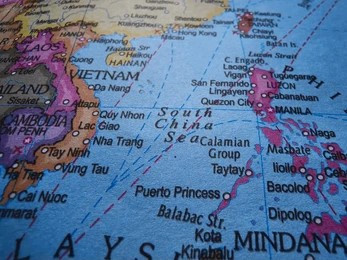Tentang KamiPedoman Media SiberKetentuan & Kebijakan PrivasiPanduan KomunitasPeringkat PenulisCara Menulis di kumparanInformasi Kerja SamaBantuanIklanKarir
2025 © PT Dynamo Media Network
Version 1.101.0
Konten dari Pengguna
South China Sea and the Belt and Road Initiative: China's Ambitions, ASEAN's
13 April 2025 13:19 WIB
·
waktu baca 6 menitTulisan dari Boby Purba tidak mewakili pandangan dari redaksi kumparan

ADVERTISEMENT
The South China Sea is one of the world's most strategic regions due to its vital trade routes, vast energy reserves, and abundant marine resources. However, it has also become a hotspot of geopolitical tension, particularly between China and several ASEAN member states, such as the Philippines, Vietnam, Malaysia, and Indonesia. This conflict is closely linked to China’s territorial claims based on the "Nine-Dash Line," which has been widely contested and deemed illegitimate by the Permanent Court of Arbitration in 2016.
ADVERTISEMENT
At the same time, China continues to expand its economic influence through the Belt and Road Initiative (BRI), aimed at building infrastructure and enhancing global connectivity. ASEAN is a key focus of BRI implementation, with various development projects such as ports, railways, and special economic zones. The interconnection between tensions in the South China Sea and China’s BRI policy highlights how Beijing leverages economic strategies to maintain its influence in the region.
Tensions in the South China Sea and Their Impact on ASEAN
The tensions in the South China Sea stem from overlapping territorial claims, further exacerbated by China’s artificial island-building and military activities in the area. ASEAN countries involved in the conflict face a dilemma between maintaining economic ties with China and upholding their territorial sovereignty. The Philippines and Vietnam, for instance, actively oppose China’s claims yet remain economically dependent on Beijing’s investments.
ADVERTISEMENT
These tensions impact regional stability, increasing the risk of military confrontations and hindering regional cooperation. ASEAN, as a multilateral organization, struggles to reach a unified stance on the South China Sea issue due to the differing interests of its member states. Some countries, such as Cambodia and Laos, tend to be more accommodating to China due to their heavy economic reliance on BRI investments.
The Belt and Road Initiative as a Geopolitical Instrument
BRI serves as both an economic and geopolitical strategy for China to expand its global influence through infrastructure development in various countries. ASEAN is a priority region for BRI, with major projects such as the Jakarta-Bandung high-speed railway in Indonesia, Kuantan Port in Malaysia, and Special Economic Zones in Cambodia and Laos.
ADVERTISEMENT
Through BRI, China seeks to foster strong economic ties with ASEAN nations, ultimately strengthening its geopolitical position in the region. Countries that receive significant BRI investments tend to be more cautious in opposing China’s policies in the South China Sea. For instance, Cambodia has frequently blocked ASEAN efforts to issue strong statements against China’s actions in the disputed waters.
The Correlation Between South China Sea Tensions and BRI
There is a strong link between China’s BRI policy and tensions in the South China Sea. First, BRI serves as an economic diplomacy tool to reduce pressure on China regarding maritime disputes. Countries benefiting from BRI projects are more likely to adopt a softer stance on China’s territorial claims. Second, through infrastructure investments, China strengthens its strategic presence in the region by developing ports and transport networks that could serve military purposes in the future.
ADVERTISEMENT
Third, BRI functions as China’s effort to weaken ASEAN solidarity in handling the South China Sea issue. By increasing the economic dependence of ASEAN nations on Chinese investments, Beijing can prevent a strong regional consensus that could harm its interests. This has been evident in ASEAN meetings that failed to produce firm resolutions on the South China Sea dispute due to varying stances among member states.
Potential Military Conflict and Global Intervention
If China forcibly seizes territories in the South China Sea through military action, it is highly likely that the United States and its allies will intervene to block Beijing’s expansion. The U.S. has reaffirmed its commitment to supporting its regional allies, such as the Philippines and Japan, in countering Chinese aggression. The presence of the U.S. military in the Indo-Pacific, along with defense agreements with several ASEAN nations, increases the risk of escalating conflicts.
ADVERTISEMENT
Additionally, countries like Australia, the United Kingdom, and India have strategic interests in the region and may support the U.S. in confronting China. If the situation escalates into a direct confrontation between China and the Western alliance, these tensions could potentially trigger a Third World War with severe global consequences. Such a conflict would not only affect the Asia-Pacific region but also destabilize the global economy and political order.
Qualitative Research Approach
This analysis employs a qualitative research approach by examining official policy documents, geopolitical reports, and expert interviews to assess the interconnectedness of BRI and tensions in the South China Sea. The study also includes case studies of ASEAN nations, particularly the Philippines and Vietnam, which have had to navigate between economic dependency on China and territorial sovereignty disputes. By using content analysis and discourse evaluation from government publications, think tank assessments, and statements from regional leaders, this research highlights the complex interplay between economic policies and military strategies.
ADVERTISEMENT
Furthermore, local perspectives from affected coastal communities in ASEAN are considered to understand how geopolitical conflicts influence trade, fisheries, and economic stability at the grassroots level. This approach provides a holistic view of the issue by integrating macro-level policymaking with micro-level socio-economic impacts.
Conclusion
The tensions in the South China Sea and China’s Belt and Road Initiative (BRI) policy towards ASEAN are deeply interconnected. Through BRI, China leverages its economic power to solidify its political influence in the region and suppress opposition to its territorial claims in the South China Sea. While some ASEAN nations strive to maintain their sovereignty, economic dependence on China has made their responses more moderate. However, if China becomes increasingly aggressive in asserting control over the South China Sea, U.S. and allied intervention could further escalate the situation, potentially leading to a larger global conflict.
ADVERTISEMENT
By incorporating a qualitative research approach, this study provides a nuanced understanding of how China’s economic policies, military strategies, and regional diplomacy shape the South China Sea dispute. Moving forward, ASEAN must strike a balance between safeguarding economic interests and preserving regional sovereignty to avoid over-reliance on major powers like China.

